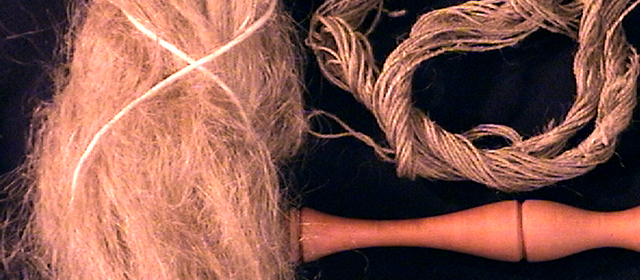Spinning flax can be a wonderful experience, but it is not highly recommended as a fiber for beginning handspinners to learn with. Following are some basic facts about flax fiber and spinning flax.
Characteristics & Types
Flax is the stalk of a plant that is used for fiber. It is considered a cellulose or bast fiber, similar to hemp, jute, and ramie. Flax, which has been spun, is called, linen.
• Plant fiber
• Line/ Stricks – long, strong, shiny fibers
• Tow – short fiber, easy to break, coarse
• no elasticity
• hard wearing, strong
• softens with age
Preparing Flax For Handspinning
Flax can be grown almost anywhere, where the growing season is three months. It has very short roots, and is harvested by pulling it out of the ground instead of cutting it. Once the stalks are pulled, they are stored in bundles, and set aside to dry. Next, they are put through a process called, rippling, which removes the seeds. Retting is the next process, which rots the outer core of the stalk to expose the inner fibers. This can be done in a variety of ways but dew and water retting are the most common methods. The next steps in the process are breaking and scutching, which breaks the stalk and removes the fiber.
Hackling is a combing process and the last process flax goes through before handspinning. This is when the short fibers, called tow are removed from the long fibers, called stricks. Stricks and tow flax are the most common forms of flax available to handspinners.
Handspinning Flax
Spinning Flax Stricks
The traditional way of spinning flax stricks is to use a distaff, but it is not required. A distaff is a long vertical pole that can be attached to the spinning wheel, or free standing next to the wheel. The long fibers of flax are tied together at one end and the rest of the fibers are fanned out. After fanning out the fibers untie them and wind the fanned fiber onto the distaff. Secure the flax onto the distaff with a ribbon or cord, beginning from the top and repeatedly crossing it until you reached a few inches above the fiber ends. Flax should be spin with little twist and light tension. Wet the fiber with your fingers as you spin, if you want to spin a smooth yarn. Do not use water if you want a hairy textured yarn.
Spinning Flax Tow
It is best to spin tow flax from the fold, either wet or dry.
The strong crisp texture of flax yarn makes it more suitable for weaving projects, rather than for knitting or crocheting.
End Uses for Flax Yarn / Linen
The end use of linen depends upon the quality of the flax. It can be woven into fabrics for summer garments, table linen, bags, etc. If spun very fine and smooth, it can be knitted or crocheted into lace. Other uses are: table cloths, tablemats, and curtains.
{{CODEflax}}


